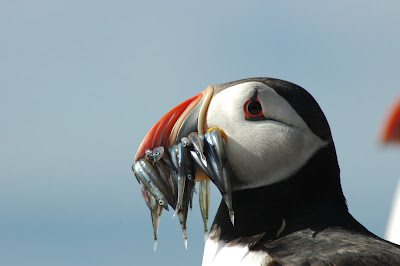c
It is early morning and we are peering out of a weathered wooden hide at some 400m2 of grassy slope – part of the largest Puffin colony in the North Sea, on the Isle of May National Nature Reserve in the entrance to the Firth of Forth, southeast Scotland. Some of the Puffins disturbed by our arrival at the hide are starting to land, while others that dived down into their burrows peer out before confidently
re-emerging. They should be used to us, since this is the 40th year that we have been watching them.
 |
| View from the hide (Liz Mackley). |
The colony is a busy place today, even though by early May most pairs will probably be incubating their single egg, deep within their burrow. However, some birds are still squabbling over the ownership of burrows. Usually this involves little more than threats but there is the occasional scrap, with the protagonists tumbling down the slope, beaks locked, wings flailing. Other birds are tugging away at clumps of dead grass and taking bundles down burrows to line the nest chambers. Periodically, a rabbit hops through the area looking slightly intimidated by all the Puffin activity. During the winter it probably lived in a Puffin burrow but has been evicted now that the owner has returned, its soft nose being no match for a Puffin’s beak!
 |
| Puffin and rabbit (Eleanor Watt). |
As well as simply enjoying watching the goings-on in the Puffin colony, our visit to the hide on this and many other mornings has a more scientific purpose. We are trying to read all the colour-ring combinations of the birds that are present, and this is best done early in the season before the vegetation has grown. At the end of the 2010 season, 158 colour-ringed Puffins were known to be alive, and so far this season we have recorded 75% of these at least once. There is still plenty of time to tick off more birds but already it is clear that that survival rate over the 2010–11 winter has been good, since the resighting rate is approaching the normal 80–85%. Actual survival is always a little higher than the resighting rate, since we never see all the birds alive.
The Puffin that we would love to see, but sadly probably won’t, is ‘yellow-blue left, yellow-BTO ring right’, a male ringed as a breeding adult in 1974, when he would have been at least five years old. He last bred in burrow number 100 in 2005 and was present in the colony in 2006 and 2008, when he would have been at least 39 years old. Currently the longevity record for the Puffin is held by a bird that died in the Lofoten Islands in Norway when aged 41 years.
 |
| Colour-ringed Puffin on the Isle of May (Liz Mackley). |
On the Isle of May the Puffin is among the earliest of the seabirds to breed, with the first egg often laid in the first few days of April. The incubation period lasts 40–42 days, so we are now looking forward to one of the highlights of summer at a seabird colony, seeing the first Puffin carrying fish ashore.
 |
| Puffin carrying sandeels (Akinori Takahashi). |
Mike and Sarah are the authors of our forthcoming Poyser monograph The Puffin – coming soon!



Great capture! I like the puffin!
ReplyDeletei love puffins!!!great photos!!!
ReplyDelete